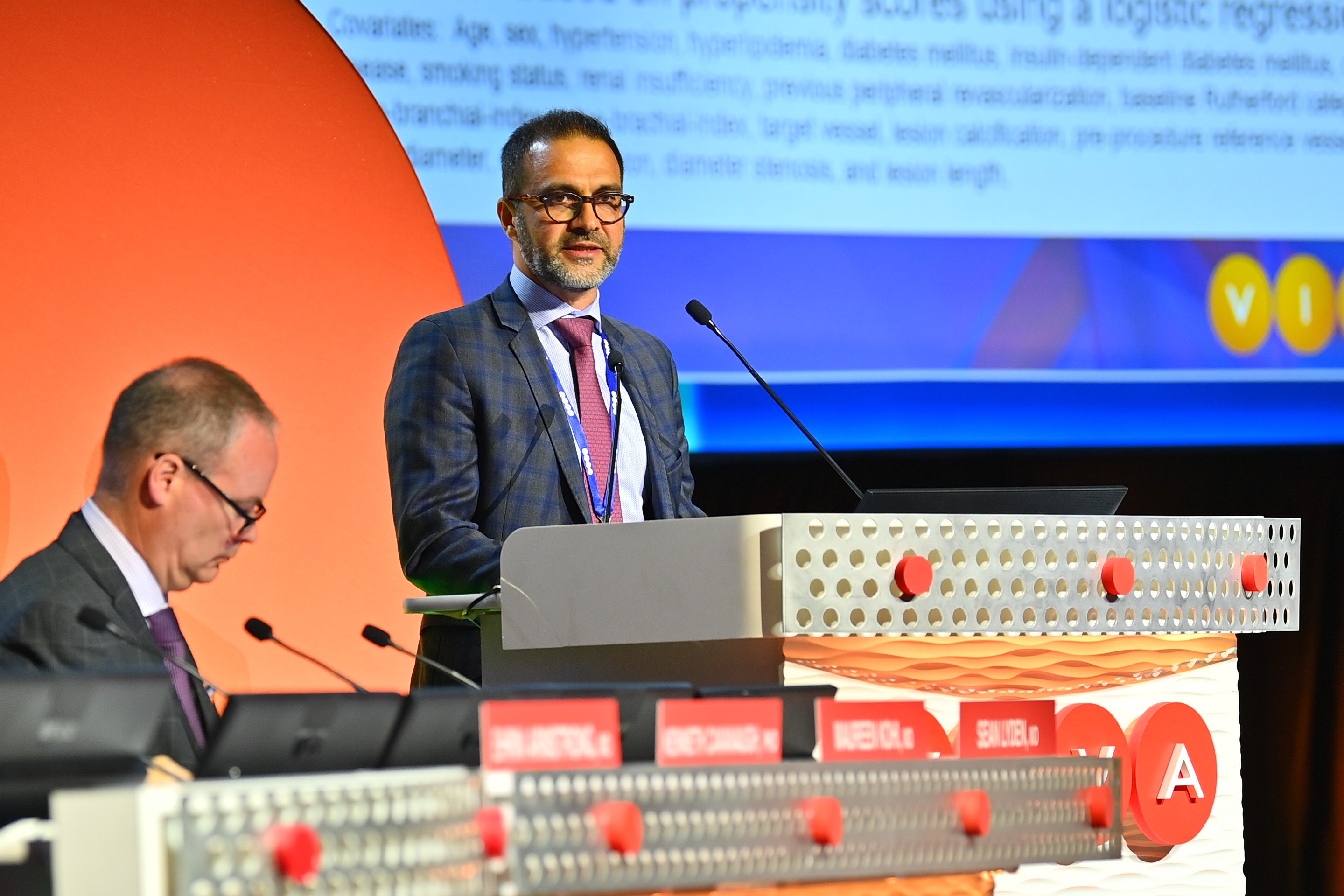
November 1, 2022
First Round of Late-Breaking Clinical Trial Results Announced at VIVA22
LAS VEGAS, Nov. 1, 2022 /PRNewswire/ -- The VIVA Foundation, a not-for-profit organization dedicated to advancing the field of vascular medicine and intervention through education and research, announces the results for the first of three Late-Breaking Clinical Trials sessions at the VIVA22 conference, hosted at Wynn Las Vegas.
VIVA (Vascular InterVentional Advances) is an annual vascular education symposium that brings together a global, multispecialty faculty to present a variety of talks and live case presentations from clinical centers around the world. Attendees include an audience of interventional cardiologists, interventional radiologists, vascular surgeons, and endovascular medicine specialists. Below are highlights of this morning's 5 late-breaking clinical trial presentations.
A Patient-Level, Propensity-Adjusted Comparison of Drug-Coated Balloons Versus Bare-Metal Stents in Femoropopliteal Lesions: Three-Year Results in Prospective, Multicenter Studies
Presented by Mehdi Shishehbor, DO, MPH, PhD
Simultaneously published in Journal of the American College of Cardiology (JACC)
Endovascular treatment of femoropopliteal artery disease has shifted toward drug-coated balloons (DCBs); however, limited data are available regarding the safety and effectiveness of DCBs versus bare-metal stents (BMSs). Using advanced statistical methods for patient-level evaluation of prospectively collected, core laboratory–adjudicated data, this analysis demonstrated superior 12-month patency and 36-month freedom from clinically driven target lesion revascularization (CD-TLR) for DCBs compared to BMSs.
Patient-level data were pooled from the DCB arms of the IN.PACT SFA I/II and IN.PACT SFA Japan randomized controlled trials and the prospective, multicenter, single-arm Complete SE and DURABILITY II BMS studies. DCBs and BMSs were compared using the inverse probability of treatment weight (IPTW) method with weighted log-rank P values. A total of 771 patients (288 DCB, 483 BMS) were included in the primary analysis. Demographic, baseline lesion, and procedural characteristics were matched between treatment groups after the IPTW adjustment. Based on IPTW-adjusted Kaplan-Meier estimates, the 12-month primary patency (90.4% DCB vs 80.9% BMS; P = .007), freedom from 36-month CD-TLR (85.6% DCB vs 73.7% BMS; P = .001), and cumulative 36-month major adverse events (25.3% DCB vs 38.8% BMS; P < .001) differed significantly, favoring the DCB group. There were no statistically significant differences observed in the cumulative incidence of IPTW-adjusted all-cause mortality (9.5% DCB vs 13.0% BMS; P = .23), major target limb amputation (0.0% DCB vs 0.8% BMS; P = .29), or thrombosis at the target lesion site (1.0% DCB vs 2.1% BMS; P = .41) through 36 months, although rates were numerically lower in the DCB group.
The results of this analysis support the primary use of DCB versus BMS in moderately complex femoropopliteal lesions, with superior effectiveness and no differences in mortality, amputation, or thrombosis. DCBs may provide a durable benefit over BMSs in femoropopliteal lesions amenable to both treatments, supporting DCBs as a first-line treatment strategy when both treatment options are at equipoise.
Intermediate-Term (24-Month) Results of the TRANSCEND Study Comparing a Next-Generation Paclitaxel Drug-Coated Balloon (SurVeil DCB) to IN.PACT DCB in the Treatment of Femoropopliteal Artery Disease
Presented by Kenneth Rosenfield, MD, MHCDS
The TRANSCEND study aims to demonstrate the safety and efficacy of the SurVeil drug-coated balloon (DCB; Surmodics, Inc.) for the treatment of patients with symptomatic peripheral artery disease (PAD) due to stenosis of the femoral and/or popliteal arteries, as well as demonstrate noninferiority to the IN.PACT Admiral DCB (Medtronic).
The TRANSCEND study (NCT03241459), a global, multicenter, pivotal IDE clinical trial, randomized 446 patients with femoropopliteal disease and Rutherford class (RC) 2-4 to either the low-dose (2.0 µg/mm2) paclitaxel DCB (SurVeil) (n = 222) or the high-dose (3.5 µg/mm2) paclitaxel DCB (IN.PACT) (n = 224). Patient outcomes are collected at 1, 6, 12, 24, 36, 48, and 60 months. Intermediate-term (24-month) secondary outcomes included primary patency, target vessel patency, clinically driven target lesion revascularization (CD-TLR), major target limb amputation (TLA), thrombosis at the target lesion, and change in target limb RC.
A total of 362/384 (94.2%) patients completed their 24-month visit. K-M primary patency at 24 months was 70.8% for SurVeil DCB versus 70.4% for IN.PACT Admiral DCB (log rank P = .991). CD-TLR was comparable (14.7% vs 11.8%; P = .453). Secondary endpoints for SurVeil versus IN.PACT were statistically comparable, including target vessel patency (63.0% vs 63.1%; P = 1.000), major TLA (0.0% vs 0.5%; P = 1.000), thrombosis at the target lesion (0.6% vs 0.0%; P = .470), change in ankle-brachial index (0.2 ± 0.2 for both groups; P = .345), and change in target limb RC (improvement by ≥ 1 category, 88.5% vs 89.3%; P = .104). Quality-of-life measures including Peripheral Academic Research Consortium symptom classification, Walking Impairment Questionnaire, and Peripheral Artery Questionnaire showed comparable improvements between groups.
The SurVeil DCB previously demonstrated noninferior primary safety and effectiveness outcomes through 12 months with a lower paclitaxel dose. Intermediate-term follow-up at 24 months continues to demonstrate similar outcomes for the Surveil DCB compared with high-dose DCB in the treatment of femoropopliteal lesions.
Percutaneous Bypass for Treatment of Femoropopliteal Disease: One-Year Outcomes of the DETOUR-2 Study
Presented by Sean Lyden, MD
The DETOUR 2 trial is a prospective, single-arm, multicenter, international clinical investigation to evaluate the safety and effectiveness of the DETOUR system (Endologix).
A total of 220 patients were enrolled at 36 investigational centers in the United States and Europe. Eligible patients had symptomatic lesions ≥ 20 cm, chronic total occlusions (CTOs), or a ≥ 70% lesion including de novo, restenotic, or in-stent restenosis. Follow-up occurred at 1, 6, 12, 24, and 36 months postprocedure.
The mean age was 68.9 years, and 73.8% were men. Baseline comorbidities were hypertension (87.6%; 177/202), diabetes (34.7%; 70/202), renal insufficiency (10.9%; 22/202), and coronary artery disease (46.0%; 92/200). The most frequent Rutherford category was category 3 (77.7%; 157/202), and the average ankle-brachial index was 0.60 ± 0.21.
Baseline lesion characteristics included CTO (96.0%; 194/202), diffuse stenosis > 70% (97.0%; 196/202), and severe calcification (70.4%; 126/179). The mean lesion length was 327 ± 61 mm and mean CTO length was 217 ± 86 mm.
The primary safety endpoint was freedom from major adverse events (MAEs) at 30 days. MAEs included death, clinically driven target lesion revascularization (CD-TLR), amputation of the treated limb, symptomatic deep vein thrombosis, pulmonary embolism, and procedure-related bleeding requiring transfusion of packed red blood cells or surgery. Freedom from MAE at 30 days was 93.0% (185/199).
The primary effectiveness endpoint is patency at 12 months postprocedure. Patency is defined as the absence of CD-TLR and absence of recurrent target lesion diameter stenosis > 50%. Patency at 12 months was 68.1% (128/188). The Kaplan-Meier estimate of CD-TLR and absence of recurrent target lesion diameter stenosis > 50% at 12 months was 72.1%.
The lower one-sided CI was above the performance goal, indicating that the prespecified primary safety and effectiveness endpoints were met. The DETOUR system is a unique treatment strategy that allows an endovascular approach to traditional surgical procedures for femoropopliteal bypass.
36-Month Outcomes for the BioMimics 3D Stent in Longer Lesions: A Subgroup Analysis of the MIMICS-3D EU Registry
Presented by Michael Lichtenberg, MD
Improvement in femoropopliteal stent design is needed to successfully treat longer, real-world, complex disease.
BioMimics 3D (Veryan Medical) is a unique nitinol stent incorporating a three-dimensional (3D) helical centerline, which provides biomechanical stability, promotes swirling blood flow, and beneficially elevates wall shear stress in the stented segment. A post hoc subgroup analysis of the prospective, single-arm, multicenter MIMICS-3D EU registry investigated the 3-year performance of BioMimics 3D in patients with long lesion (LL) length 140 to 190 mm (N = 46) and very long lesion (VLL) length > 190 mm (N = 119).
The MIMICS-3D registry enrolled 507 patients at 23 European sites. The LL or VLL cohort consisted of 165 patients (33%), with 46 in the LL subgroup (mean lesion length, 160.2 ± 22.6 mm; 33% diabetes; 25% severe bilateral wall calcification; 58% occlusion) and 119 in the VLL subgroup (mean lesion length, 269 ± 61 mm; 40% diabetes; 38% severe bilateral wall calcification; 92% occlusion). Primary safety outcome of major adverse events (MAEs) was 100% for the LL subgroup and 97% for the VLL subgroup. The primary efficacy endpoint demonstrated as Kaplan-Maier estimate for freedom from clinically driven target lesion revascularization (CD-TLR) was 85% and 78% at 12 and 36 months, respectively, for the LL subgroup and 82% and 70% at 12 and 36 months, respectively, for the VLL subgroup. The Kaplan-Meier estimate of primary patency was 85% and 75% at 12 and 36 months, respectively, for the LL subgroup and 78% and 61% at 12 and 36 months, respectively, for the VLL subgroup. Investigator-reported fractures through 36 months were low for both groups (0% for LL and 0.8% for VLL, respectively).
These results support the hypothesis that imparting a nonplanar curvature nitinol stent design to the femoropopliteal artery to promote swirling blood flow and increase wall shear stress is beneficial and contributes to a 36-month CD-TLR rate comparable to those of drug-based devices, even in long and very long lesions, with minimal fracture risk.
Intravascular Lithotripsy for the Treatment of Peripheral Artery Calcification: Results From the Disrupt PAD III Observational Study
Presented by Ehrin J. Armstrong, MD
The aim of the Disrupt PAD III observational study is to evaluate the performance of intravascular lithotripsy (IVL) in the treatment of calcified peripheral artery disease (PAD). The Disrupt PAD III observational study is a prospective, multicenter, single-arm, independent core lab–assessed study designed to evaluate the acute safety and effectiveness of the Shockwave peripheral IVL system (Shockwave Medical). Multivariate analysis was performed to assess independent predictors of stenosis reduction and angiographic complications.
A total of 1,373 patients with 1,677 lesions were enrolled between November 2017 and June 2021. 91.3% (1,531/1,677) of lesions were evaluable. Diameter stenosis, lesion length, and Peripheral Academic Research Consortium–defined moderate-severe calcification at baseline were 80.6 ± 17.6%, 93.5 ± 74.3 mm, and 89.9%, respectively. Treated vessels included femoropopliteal (60.7%), iliac (15.8%), common femoral (10.7%), and infrapopliteal arteries (12.8%). Target lesions included 31% chronic total occlusions (CTOs), 19.3% long lesions (≥ 15 cm), and 20.1% eccentric lesions. Concomitant use of atherectomy and/or specialty balloon technology was observed in 22.1% of lesions. Residual stenosis immediately following IVL treatment and at the end of the procedure was 32.5% ± 16.3% and 23.8% ± 11.3%, respectively. After final treatment, there were 0.9% serious angiographic complications (0.7% flow-limiting dissections, 0.2% perforations) with zero abrupt closures, distal embolizations, no flows, or thrombotic events. Independent predictors for final residual stenosis ≤ 30% were lesion length ≥ 15 cm (odds ratio [OR], 0.384; 95% CI, 0.283-0.521), female sex (OR, 1.850; 95% CI, 1.376-2.489), age ≤ 75 years (OR, 1.625; 95% CI, 1.247-2.117), IVL balloon–to-artery ratio ≥ 1.0 (OR, 1.538; 95% CI, 1.189-1.989), and CTO (OR, 0.638; 95% CI, 0.482-0.844). Lesion length ≥ 15 cm was an independent predictor for angiographic complications (OR, 16.076; 95% CI, 3.394-76.152).
The full cohort analysis of the Disrupt PAD III observational study represents the largest analysis of periprocedural outcomes following IVL treatment. The importance of proper IVL balloon sizing was confirmed by multivariate analysis. Use of peripheral IVL demonstrated excellent procedural safety and effectiveness in complex lesions across multiple vascular beds.
About the VIVA Foundation
The VIVA Foundation, a not-for-profit organization dedicated to advancing the field of vascular medicine and intervention through education and research, strives to be the premier educator in the field. Our team of specialists in vascular medicine, interventional cardiology, interventional radiology, and vascular surgery is driven by the passion to advance the field and improve patient outcomes. Educational events presented by the have a distinct spirit of collegiality attained by synergizing collective talents to promote awareness and innovative therapeutic options for vascular disease worldwide. To learn more about the VIVA Foundation, visit https://thevivafoundation.org/.
